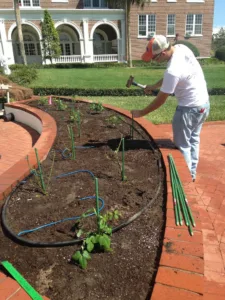Introduction
When it comes to gardening, every detail matters, from the soil you choose to the stakes that support your plants. Among the myriad of decisions gardeners face, the choice between fiberglass and wood plant stakes stands out as particularly significant. This choice not only affects the health and growth of your plants but also impacts your garden’s aesthetics and sustainability. In this article, we delve into the crucial comparison of fiberglass vs. wood plant stakes, providing gardeners with all the information needed to make an informed decision.

fiberglass plant stake
Fiberglass vs. Wood Plant Stakes: An Overview
Plant stakes are essential for supporting and training plants, ensuring they grow upright and healthy. Fiberglass stakes offer modern technology’s durability and strength, while wood stakes bring a classic, natural touch to your garden. Each has its pros and cons, from weather resistance to environmental friendliness, affecting their suitability for different gardening needs.
Benefits of Fiberglass Stakes
Fiberglass stakes are known for their remarkable durability and resistance to weather conditions. Their ease of use makes them a popular choice among gardeners who value longevity and minimal maintenance. These stakes won’t rot or splinter, ensuring your garden’s structure remains intact season after season.
Advantages of Wood Plant Stakes
Wood plant stakes are prized for their natural aesthetics, blending seamlessly into any garden setting. They are environmentally friendly, often sourced from sustainable forests, and are biodegradable, making them a great choice for eco-conscious gardeners. Additionally, their cost-effectiveness makes them accessible for gardeners on a budget.
Comparative Analysis: Durability and Longevity
When comparing fiberglass and wood stakes, it’s essential to consider their lifespan and maintenance needs. Fiberglass stakes often outlast wood stakes, which can suffer from rot and pest damage over time. However, proper treatment and care can extend the life of wood stakes, making them a viable option for many gardeners.
Impact on Plant Health
The primary purpose of any plant stake is to support plant growth. Both fiberglass and wood stakes offer strong support, but their interaction with plants can differ. For instance, wood stakes, being more porous, may provide a slightly better grip for climbing plants compared to the smoother surface of fiberglass stakes.
Environmental Considerations
Sustainability is a growing concern in gardening practices. Wood stakes are biodegradable and can be sourced from sustainable forests, making them an environmentally friendly option. On the other hand, fiberglass stakes, while not biodegradable, offer durability that reduces the need for frequent replacements, contributing to less waste over time.
Cost Comparison
Initial investment and long-term value are crucial factors in choosing between fiberglass and wood stakes. Fiberglass stakes may have a higher upfront cost but their durability means fewer replacements. Wood stakes, while cheaper initially, may need to be replaced more often, especially in harsh weather conditions.
Ease of Installation and Use
Gardeners value ease of use, and both types of stakes offer advantages. Fiberglass stakes are lightweight and easy to install, while wood stakes can be cut to custom lengths, offering flexibility in use. The choice often comes down to personal preference and the specific needs of the garden.
Aesthetic Appeal
The visual impact of your garden is important. Wood stakes offer a natural, rustic look that many gardeners prefer, while fiberglass stakes can be less obtrusive, maintaining focus on the plants themselves. Some fiberglass stakes are also available in colors that blend with the garden environment.
Fiberglass vs. Wood Plant Stakes: Which is Better for Your Garden?
The decision between fiberglass and wood plant stakes depends on various factors, including durability, environmental impact, cost, and aesthetic preference. Gardeners should consider their specific needs, the types of plants they are supporting, and their long-term gardening goals when making their choice.
Conclusion
In the debate of fiberglass vs. wood plant stakes, there’s no one-size-fits-all answer. Each type of stake has its benefits and drawbacks, and the best choice depends on individual gardening needs and values. By considering the factors outlined in this article, gardeners can select the stakes that will best support their plants and contribute to a thriving, beautiful garden.




























